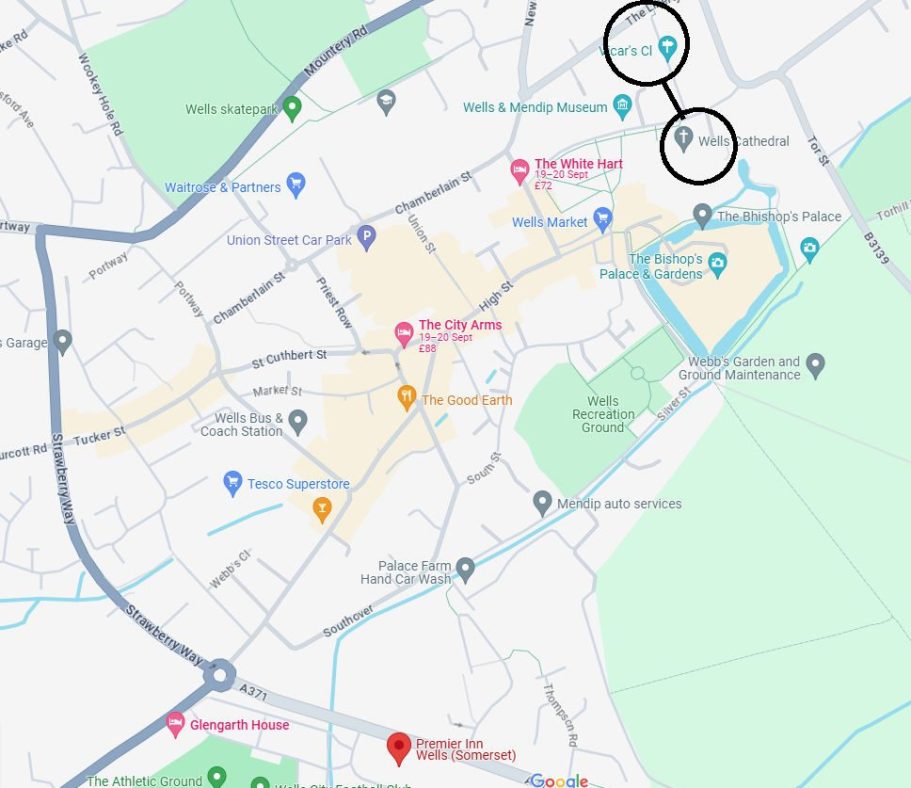The Vicars Close
Vicars Close
Information by WikiPeadia. Wells Cathedral - Wikipedia
Constructed in the mid-14th century, this is the oldest continuously inhabited medieval street in Europe. The inception, evolution, and preservation of Vicars Close paint a vivid picture of architectural ambition and communal living from centuries past.
Vicars Close was conceptualised and built with a purpose that has endured through the ages. Here are key dates that mark its historical journey.
1348: Construction of Vicars Close begins, initiated by Bishop Ralph of Shrewsbury to house the Vicars Choral, who sang daily services in Wells Cathedral.
1363: The building of the Vicars’ Hall and the consolidation of the Close’s structure to further accommodate the needs of the vicars.
1612: Introduction of modifications to the original buildings to improve living conditions, reflecting the evolving architectural styles and residential needs.
1840s: Restoration efforts led by Benjamin Ferrey to preserve the medieval character of the Close while implementing Victorian-era enhancements.
1960s: Another phase of restoration is undertaken, emphasising the preservation of historical accuracy in the face of modern pressures.
2023: Recent grants, including significant funding from the National Lottery, have been allocated for further preservation and to make Vicars Close more accessible to the public.
Just a few yards away from the Cathedral Green, Vicars’ Close was derived from a significant land grant by the canon of Wells Cathedral, Walter de Hulle. The small, picturesque, terraced houses that sit either side of a cobbled street, were originally built to house a vicar each.
The foundation of Vicars Close was laid with a vision of harmony and functionality. Designed specifically for the Vicars Choral, the close was both a retreat and a practical living space for those dedicated to the cathedral’s services. The street’s unique architectural elements, such as the deliberate narrowing towards the chapel, and its aligned chimneys, were designed to foster a sense of community and spiritual devotion.
The Close consists of picturesque limestone houses, a stunning chapel, and a communal hall, all aligned to form a cohesive medieval streetscape.
The street is about 140m long and 10m wide – at some points! There is a fascinating optical illusion built-in to the street! You might find that the Close appears in different sizes when you stand at either end. From the cathedral side at the south, it appears a lot longer than its true size. Then, as you make your way to the north end of the close it appears much shorter. This is due to the cobbled pathway gradually getting wider as you walk towards the Cathedral!




Built for Bishop Ralph of Shrewsbury, Vicars’ Close was founded in the 1300s, it is thought to be the oldest entirely residential street in England. Some believe it is the oldest surviving residential street in all of Europe. In the 1660s some of the houses were allowed to be leased by ‘strangers’.
Originally there were 42 houses but there are now 27 – all of them Grade 1 listed buildings.
Over the centuries, Vicars Close has seen various restoration efforts, each respectful of its original medieval architecture, yet each phase subtly infusing the evolving architectural trends of the respective periods. Its significance extends beyond architecture; Vicars Close has been a backdrop for numerous films and is a focal point for cultural studies and medieval history, making it an invaluable resource for scholars and enthusiasts alike.
The chapel at the end of the Close is used by the Wells Cathedral School. There is also a library, treasury and muniment room, as well as a dining hall connected to the Cathedral by a covered walkway, the Chain Gate Bridge.

Vicars Close is very close to the Cathedral and well worth a visit.
We need your consent to load the translations
We use a third-party service to translate the website content that may collect data about your activity. Please review the details in the privacy policy and accept the service to view the translations.
